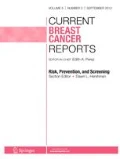Abstract
Based on historic, retrospective data, most surgeons recommend mastectomy for women with multiple ipsilateral breast cancers (MIBC) due to a perceived prohibitively high risk of local recurrence. More recent retrospective studies, however, have documented acceptable local recurrence rates in women with MIBC who have undergone breast conservation with lumpectomy and radiation therapy. The recent data suggest that earlier detection, improved margin analysis, and increased use and efficacy of targeted therapies all contribute to the decreased risk of local recurrence when compared to rates historically documented in this MIBC population. Appropriate surgical management for MIBC is of growing importance. Pre-operative identification of MIBC has increased in the past decade due to the increased use of MRI and improved mammographic and sonographic sensitivity. Review of the current literature supports the use breast conservation with one or more partial mastectomies and sentinel node biopsy in appropriately selected patients with MIBC.
Similar content being viewed by others
References
Papers of particular interest, published recently, have been highlighted as: • Of importance, •• Of major importance
Veronesi U, Cascinelli N, et al. Twenty-year follow-up of a randomized study comparing breast-conserving surgery with radical mastectomy for early breast cancer. N Engl J Med. 2002;347(16):1227–32.
Fisher B, Anderson S, Bryant J, et al. Twenty-year follow-up of a randomized trial comparing total mastectomy, lumpectomy, and lumpectomy plus irradiation for the treatment of iInvasive breast cancer. NEJM. 2002;347:1233–41.
Fisher B, Costantino J, Redmond C, Fisher E, Margolese R, Dimitrov N, et al. Lumpectomy compared with lumpectomy and radiation therapy for the treatment of intraductal breast cancer. N Engl J Med. 1993;328:1581–6.
Coombs NJ, et al. Multifocal and multicentric breast cancer: does each focus matter? J Clin Oncol. 2005;23:7497–502.
Sardanelli F, et al. Sensitivity of MRI versus mammographcy for detecting foci of multifocal, multicentric breast cancer in fatty and dense breasts using the whole breast pathologic examination as a gold standard. AJR Am J Roentgenol. 2004;183:1149–57.
Bendifallah S, Werkoff G, Borie-Moutafoff C, Antoine M, Chopier J, Gligorov J, Uzan S, Coutant C, Rouzier R. Multiple synchronous (multifocal and multicentric) breast cancer: clinical implications. Surg Oncol. 2010;19(4):e115–23.
Berg WA, Gilbreath PL. Multicentric and multifocal cancer: whole-breast US in preoperative evaluation. Radiology. 2000;214(1):59–66.
Berg WA, Madsen KS, Schilling K, Tartar M, Pisano ED, Larsen LH, Narayanan D, Ozonoff A, Miller JP, Kalinyak JE. Breast cancer: comparative effectiveness of positron emission mammography and MR imaging in presurgical planning for the ipsilateral breast. Radiology. 2011;258(1):59–72.
Houssami N, Ciatto S, Macaskill P, Lord SJ, Warren RM, Dixon JM, Irwig L. Accuracy and surgical impact of magnetic resonance imaging in breast cancer staging: systematic review and meta-analysis in detection of multifocal and multicentric cancer. J Clin Oncol. 2008;26(19):3248–58.
Moon WK, Noh DY, Im JG. Multifocal, multicentric, and contralateral breast cancers: bilateral whole-breast US in the preoperative evaluation of patients. Radiology. 2002;224(2):569–76.
Wilkinson LS, Given-Wilson R, Hall T, Potts H, Sharma AK, Smith E. Increasing the diagnosis of multifocal primary breast cancer by the use of bilateral whole-breast ultrasound. Clin Radiol. 2005;60(5):573–8.
Arrington AK, Jarosek SL, Virnig BA, Habermann EB, Tuttle TM. Patient and surgeon characteristics associated with increased use of contralateral prophylactic mastectomy in patients with breast cancer. Ann Surg Oncol. 2009;16(10):2697–704.
Sorbero ME, Dick AW, Beckjord EB, Ahrendt G. Diagnostic breast magnetic resonance imaging and contralateral prophylactic mastectomy. Ann Surg Oncol. 2009;16(6):1597–605.
Wood, W. C. "Should the use of contralateral prophylactic mastectomy be increasing as it is?" Breast 2009 18 Suppl 3: S93-95. PMID: 19914552
•• Fisher, B. “Role of Science in the Treatment of Breast Cancer When Tumor Multicentricity is Present.” J Natl Cancer Inst. 2011 103(17): 1292–1298. PMID: 21765010. This is a compelling editorial that advocates for breast conservation in the MIBC population. Fisher uses scientific evidence from early breast cancer trials, including NSABP B06, to document the oncologic safety of breast conservation in this patient population. It also addresses the regression to mastectomy in lieu of breast conservation.
Leopold KA, Recht A, et al. Results of conservative surgery and radiation therapy or multiple synchronous cancers of one breast. Int J Radiat Oncol Biol Phys. 1989;16(1):11–6.
Kurtz JM, Jacquemier J, et al. Breast conserving therapy for macroscopically multiple cancer. Ann Surg. 1990;212:38–44.
Wilson LD, Beinfield M, et al. Conservative surgery and radiation in the treatment of synchronous ipsilateral breast cancers. Cancer. 1993;72(1):137–43.
Fowble B, Yeh I, et al. The role of mastectomy in patients with stage I-II breast cancer presenting with gross multifocal or multicentric disease or diffuse microcalcifications. Int J Radiat Oncol Biol Phys. 1993;27(3):567–73.
Singletary E. Surgical margins in patients with early-stage breast cancer treated with breast conservation therapy. Am J Surg. 2002;184(5):383–93.
Macdonald H. Margin width as the sole determinant of local recurrence after breast conservation surgery in patients with ductal carcinoma in situ of the breast. Am J Surg. 2006;192(4):420–2.
Smith R, Saslow D. American Cancer Society guidelines for breast cancer screening. Clin Canc J. 2003;53(3):141–69.
Barth R. Detection of breast cancer on screening mammography allows patients to be treated with less toxic therapy. Am J Roentgenol. 2005;184(1):324–9.
Cho LC, Senzer N, et al. Conservative surgery and radiation therapy for macroscopically multiple ipsilateral invasive breast cancers. Am J Surg. 2002;183:650–4.
Giron G, et al. Breast conservation in patients with multiple ipsilateral synchronous breast cancers. J Am Coll Surg. 2003;187:726–9.
Lim W, Park E, et al. Breast conserving surgery for multifocal breast cancer. Ann Surg. 2009;249:87–90.
• Gentilini O, Rotteri E et al. Conservative surgery in patients with multifocal/multicentric breast cancer. Breast Cancer Res Treat. 2009:113(3): 577–83. This is one of the largest retrospective studies to examine if breast conservation is safe in women with MIBC. The follow-up is satisfactory at over 6 years. The study elucidates risk factors for increased LR including HER2-positive disease and ER/PR-negative disease. This study also emphasizes the need for appropriate adjuvant therapy.
•• Yerushalmi, R, Tyldesley, S, Woods, R et al. Is breast-conserving therapy a safe option for patients with tumor multicentricity and multifocality? Ann Onc. 2011 Aug epub ahead of print. This article tracks the largest known series of MIBC over the longest median follow-up. The authors perform univariate and multivariate analyses to inform their conclusions that well-selected patients with MIBC are candidates for BCT, with equivalent oncologic outcomes in comparison to those who undergo mastectomy and those who undergo breast conservation for unifocal disease.
Oh JL, Dryden MJ, Woodward WA, Yu TK, Tereffe W, Strom EA, Perkins GH, Middleton L, Hunt KK, Giordano SH, Oswald MJ, Domain D, Buchholz TA. Locoregional control of clinically diagnosed multifocal or multicentric breast cancer after neoadjuvant chemotherapy and locoregional therapy. J Clin Oncol. 2006;24(31):4971–5.
Veronesi U, Paganelli G, Galimberti V, et al. Sentinel node biopsy to avoid axillary dissection in breast cancer with clinically negative lymph-nodes. Lancet. 1997;349:1864–7.
Andea AA, et al. Pathologic analysis of tumor size and lymph node status in multifocal/multicentric breast cancer. Cancer. 2002;94:1383–90.
Schrenk P, Wayand W. Sentinel –node biopsy in axillary lymph-node staging for patients with multicentric breast cancer. Lancet. 2001;35:122.
Kumar R, Jana S, Heiba S, et al. Retrospective analysis of sentinel node localization in multifocal, multicentric, palpale or nonpalpable breast cancer. J Nucl Med. 2002;44:7–10.
Lyman FH, et al. American Society of Clinical Oncology guideline recommendations for sentinel lymph node biopsy in early stage breast cancer. J Clin Oncol. 2005;23:7703–20.
Patini N, Carpenter R. Oncological and aesthetic considerations of conservational surgery for multifocal/multicentric breast cancer. Breast J. 2010;16(3):222–30.
Cablioglu N, et al. Increased lymph node positivity in multifocal and multicentric breast cancer. J Am Coll Surg. 2009;208(1):67–74.
Bevilacqua JL, Kattan MW. Doctor, what are my chances of having a positive sentinel node? A validated nomogram for risk estimation. J Clin Oncol. 2007;25(24):3670–9.
Chua B, Ung O, et al. Frequency and predictors of axillary lymph node metastases in invasive breast cancer. ANZ J Surg. 2001;71:723–8.
Van Zee KJ, Kattan MW. Validating a predictive model for presence of additional disease in the non-sentinel lymph nodes of a woman with sentinel node positive breast cancer. Ann Surg Oncol. 2007;14(8):2177–8.
Bauman L, et al. Breast conservation in women with multifocal-multicentric breast cancer: is it feasible? Ann Surg Oncol. 2010;17 Suppl 3:325–9.
Hartsell WF, Recine R, Griem KL, Cobleigh MA, Witt TR, Murthy AK. Should multicentric disease be an absolute contraindication to the use of breast conserving therapy. Int J Radiat Oncol Biol Phys 1994;30(1):49–53.
Disclosure
No conflicts of interest relevant to this article were reported.
Author information
Authors and Affiliations
Corresponding author
Rights and permissions
About this article
Cite this article
Rosenkranz, K. Multiple Ipsilateral Breast Cancers: Current Strategies for Surgical Management. Curr Breast Cancer Rep 4, 148–152 (2012). https://doi.org/10.1007/s12609-012-0075-7
Published:
Issue Date:
DOI: https://doi.org/10.1007/s12609-012-0075-7




